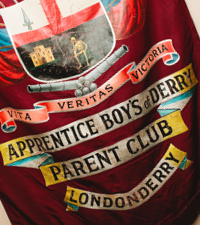Association Structure
The full title of the organisation is the “Associated Clubs of the Apprentice Boys of Derry”
This is derived from the fact that the organisation is essentially a number of separate Clubs who came together to form the organisation as it is today
Association Structure
The first Apprentice Boys Club was formed on 1st August, 1714 (the date of the annual commemoration that year) by Colonel John Mitchelburne who had been Governor of the City towards the end of the Siege.
Although this Club ceased to exist after his death, the memory of the Siege was always celebrated each year in some form by informal groups right through the 18th century.
The first formal ‘Apprentice Boys of Derry Club’ was formed in 1814 by Benjamin J Darcus. Over the next 40 years or so, other Clubs were founded to commemorate the Siege heroes.
In 1859 six Clubs came together to form the Associated Clubs of the Apprentice Boys of Derry.

The Apprentice Boys Memorial Hall is best known as the headquarters of the Apprentice Boys of Derry, with the adjacent Siege Museum open late 2015.

There are eight Parent Clubs based in the City of Londonderry, symbolising the regiments formed during the siege to defend the city.
Eight Clubs
The original six Clubs were the Apprentice Boys of Derry, Walker, Mitcheburne, Baker, Murray and Williamite Clubs. The Williamite Club became extinct, but three new Clubs were founded called No Surrender, Browning and Campsie bringing the number of clubs to the current eight.
Parent Clubs
Each of the eight Clubs is based in Londonderry with a Parent Club meeting in the Apprentice Boys Memorial Hall. The Londonderry Clubs became known as Parent Clubs following the opening of Branch Clubs outside the city.
Branch Clubs
Any Club of the Association formed outside of Londonderry is called a Branch Club. Branch Clubs are an extension of one of the Clubs in Londonderry and take the name of their Parent Club eg. Lurgan Apprentice Boys of Derry Club or Edinburgh Campsie Club.
General Committee
The ruling body of the Association is the General Committee. It was formed in 1862 with John Guy Ferguson becoming the first Governor. Membership of the Committee is drawn from the eight Parent Clubs along with representatives from the Amalgamated Committees. All senior positions within the General Committee are held by Parent Clubs members.
Amalgamated Committees
As the number of Branch Clubs grew they formed local committees to co-ordinate their activities and to represent their area’s opinions and interests at General Committee. These committees became known as Amalgamated Committees.
